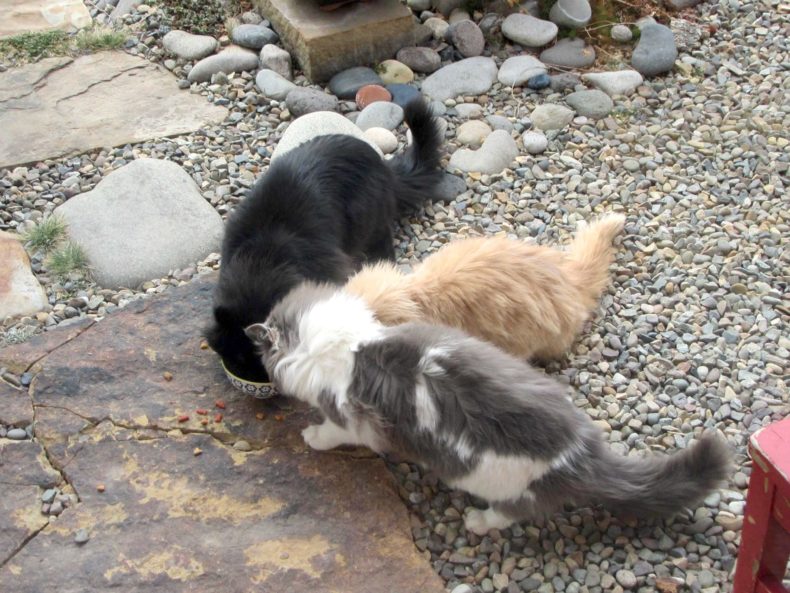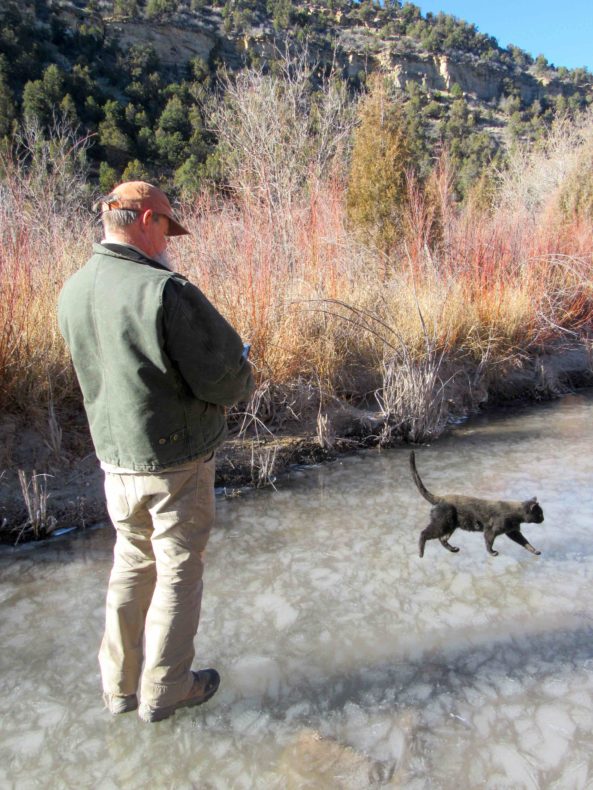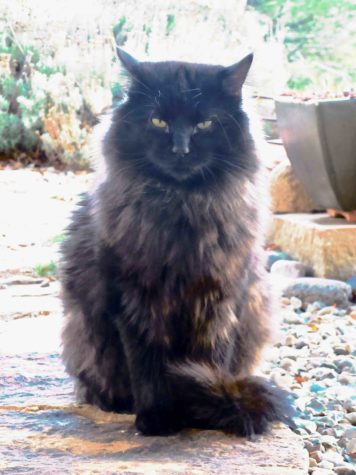
We’ve had a number of cats around here over the last year, roamers and strays. Two we brought in and three, the feral ones, came on their own.
A little more than a year ago, a barn cat showed up at a friend’s ranch an hour from where we live in southwest Colorado. It was a lanky pure black neuter, a short-hair with a nip out of one of its ears. The old man who owned the next ranch down the creek had died and one of his cats came nosing around, looking for a new home.
We needed a mouser. We brought him home and named him McElmo for McElmo Canyon, Colorado, where he came from. Though he spent many of his nights indoors, his days were out. If a door opened, he was free before you could take a step.
In the few months we had McElmo, I didn’t notice a decrease in songbirds who’d fly through every fall, but I’d be a fool to think this cat wasn’t eating birds. We’d unleashed a new predator. In the continental US, domestic cats are believed to kill from 1.4 billion to 3.7 billion birds each year. That may be concentrated in urban areas where habitats are more focused, but we were adding to the problem locally. With patience, he’d be indoors eventually, not necessarily what a barn cat wants, but we tried.
The last we saw of McElmo, he followed us on a walk to a frozen winter creek. He wandered home with us, but like usual, wouldn’t come in. Maybe he’d gotten wind of our plans for domestication.

We don’t know if he was a meal for coyotes or a mountain lion, or if he trotted fifty miles south to where he came from, done with us, back to his original home. Cats go that far. A microchipped Florida house cat was lost on a trip and, on its own, traveled 200 miles to get back.
After McElmo didn’t return, an older gentlemen living up the dirt road from us died. He had a hoard of feral cats, rumored to be 15 or 20, many bequeathed from another death, a feline domino effect. The same study that estimated annual bird kills figured that there are 30 million to 80 million “unowned” cats, strays, barn cats, and ferals in the US, and 84 million “owned” cats. How feral cat populations work around here is some survive, some don’t. People take care of the few who come by, domesticate them if they can.
Feral means reverted to an untamed state from one of domestication. They were calm at a distance, but I’ve stuffed ferals in a box to get them to a shelter or a vet. It’s all tooth and claw. They will do anything to get away.
Shortly after the neighbor’s death, three of his skittish cats showed up. All long-hairs, one black, one gray-and-white, one golden: Poe, Badger, and Lion. It took weeks to get them close, putting out a bowl of food they visited, as long as we stayed several feet away. We couldn’t get near enough to cut off their mats of fur, or to throw them in a crate for the vet to check and chop. That would take some trust.
After a month or so, the three would appear out of the woods when we rattled kibble in a soup can. If they came inside and a door closed behind them, they turned to spitfires, mewing and hissing, knocking over dishes and candlesticks. They tried leaping through windows, nose-smacking, backwards, comical and horrible at once. They could not be touched.
If a door opened and they were sitting outside, they fled, knocking into each other in a panic. We called them skitties.
Through the winter, the three watched us through our windows, as if we were entertainment inside the house, cooking, reading, typing. They seemed fascinated with our movements. Spring, summer, and fall, we worked on them. Many will say you can’t bring in a feral after it’s a kitten, but we were taking our time. If we could do it, they might have sweet, long lives.
Lion was the first of the ferals to go. I like to think it was the cold of the first snow last October. He could have moved to a better shelter than the upside-down bin padded with blankets my gal put out for them. Other houses are scattered across hillslopes and canyons around here, plenty who’d throw out a bowl for an errant golden cat looking through their windows.
If the remaining two nosed their way inside, it was only to eat and bolt at the slightest movement. One got on the couch finally. We were making progress.
Next, regal black Poe vanished. We left his/her bowl out for a couple weeks, but the cat didn’t come back; another defector, another meal.
Badger remained, maybe out of loyalty to his pad and the sound of our door opening and closing. When coyotes howled, he listened intently. Less bold than Poe, this cat would come to the door but rarely step in, wary as any feral.
By the end of November, Badger was gone.
The subject came up again around Christmas, brought up by the kids. Could we try again? A week ago we drove to a shelter in a town an hour away. We’d already stopped in and spied a lazy Russian blue, a shameless purr bag who gently padded our hands if we stop petting him. Neutered, shots, locator chip from the former owner, he came with little fuss.
The cat’s chariot was a cardboard box with a towel on the bottom. We placed the box on an inner tube and pulled it down the eighth of a mile of our snowed-in driveway. He took it all in stride as the sled slipped and bounced over ruts.
This fuzzy meatloaf with a head is now learning the house, uninterested in the door and the air that blows through its gaps. He lies on his back and rumbles with bliss. I like this cat. I’ll come to love him. He may live another 18 years with us and I don’t know if he’ll ever go outside.
We keep the upside-down bin next to the door in case the ferals return. We wonder if McElmo might tire of his old canyon and trot 50 miles back to us, a welcomed marvel for our next year of cats.

Images: Daiva Chesonis
,
I enjoyed reading this cat account. Thanks Craig!
Here’s a throwback song to go along with your new kitty.
https://open.spotify.com/track/4WamMWxFi6ts3xkIhivF5c?si=B4afe6_JTy6Nrk4asRy4PQ
I’m not in Colorado, but your feral anecdotes could be mine. FYI, the ear tip snip is the marker for spayed and neutered released ferals, the “TNR” program in action. They snip the ear tip as a marker, to save the TNR volunteers the trouble of trying to trap them again.
My mother allowed our cats to sleep on my person and in my crib during my infanthood- I am now fifty. There has never been a period in my life without cats. I have taught cats to perform tricks (& FYI, cats will learn a trick the first time you show it to him, if you teach it right) I currently own five cats, all of them were ferals in the beginning, one of them so feral that it went berserk if brought indoors- the writers “spitfires” : jumping into windows, walls – Ive never seen a creature gather enough centripetal force to be able to run the length of a bedroom’s four walls- five feet off the ground – until I lured one feral whom I know for a fact has never been inside of a human structure in it’s life. He, One Long Pan, is now so cloying and affectionate he is an annoyance.
What we assume will make a friend with a fearful animal is food- in a creatures’ mind food is nice but it won’t convince them you’re harmless. The sole method that works in my experience with feral cats, and animals in general- is play. You get a toy- and you have to find one that appeals to that individual cat, not all go for the string, some prefer the feather on a stick or the fake toy mouse, but you find their particular “lure” let’s call it, and you really have to work it. Anyone who knows how to gather and keep a cats’ attention with a toy knows how to do this, and it takes patience, time and effort. Once I learned this method- years ago, feral cats I’d been feeding for over a year and even running toward me when called (for food!) & slept in the bedding I placed out back in winter- but would not let me close enough to touch- within two weeks of the play method these terribly shy cats became ordinary, bunting & curl up with you at night in bed housecats. There is something in their brain that clicks when play is implemented. Food, no matter how delectable and no matter how starved the feral cat, has not once been a tool in taming them with me although it will draw them nearer.
By the way- if anyone wishes to learn the method in training cats to do tricks, and doesn’t already know how, email me I’d be glad to write you instructions. It is no secret really, the Russian man who has the “cat circus”? he tells it: “teach them to do a trick they already do” sort of a way of stating it.